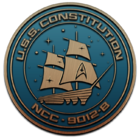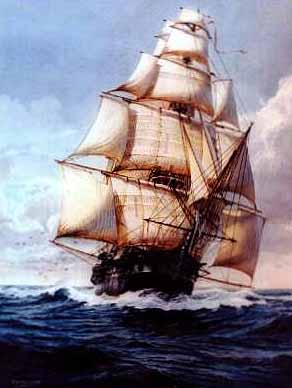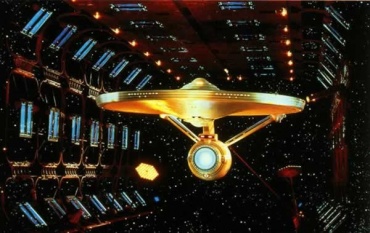Previous ships called Constitution: Difference between revisions
No edit summary |
|||
| Line 39: | Line 39: | ||
To complete the refit, the original Constitution’s bridge module was again replaced to provide an improved command area. Decommissioned at the end of the 23rd century in favour of new, more advanced starships, the original Constitution is now on displayed in a Starfleet museum as a testimony to Starfleet’s early days of pioneering. | To complete the refit, the original Constitution’s bridge module was again replaced to provide an improved command area. Decommissioned at the end of the 23rd century in favour of new, more advanced starships, the original Constitution is now on displayed in a Starfleet museum as a testimony to Starfleet’s early days of pioneering. | ||
==USS Constitution | ==USS Constitution NCC-9012-A, Ambassador Class== | ||
Following the notability and success of the original constitution and her class, it seemed wrong to name one of newer Excelsior, Oberth, Miranda or Constellation class starships after the class of vessel that they'd superseded and replaced. There was therefore no USS CONSTITUTION in Starfleet until 2341 with the creation of the Ambassador class starship. | Following the notability and success of the original constitution and her class, it seemed wrong to name one of newer Excelsior, Oberth, Miranda or Constellation class starships after the class of vessel that they'd superseded and replaced. There was therefore no USS CONSTITUTION in Starfleet until 2341 with the creation of the Ambassador class starship. | ||
Latest revision as of 08:12, 8 May 2017
| USS Constitution-B | ||
|---|---|---|
 ACTIVE STATUS | ||
| ||
USS Constitution
The United States Navy's three-masted frigate USS Constitution, better known as "Old Ironsides," is the world's oldest commissioned warship afloat.
In March 1794 Congress passed a naval act that called for the construction of a half-dozen frigates -- the 44-gun frigates Constitution, United States, and President and the 36-gun frigates Congress, Constellation, and Chesapeake. The Constellation, launched in 1797, was the first of the US Navy's original six frigates to go to sea, in June 1798.
Joshua Humphreys designed these frigates to be the Navy's capital ships, larger and more heavily armed than the standard run of frigate. Humphreys had two criteria to satisfy, to out gun the next rate ship and to out-sail adversaries. Humphreys understood that optimization of the two criteria became mutually exclusive when building a hull. Combining the weight of the guns and the buoyancy curve of a fast sailing hull results in a force that distorts the hull. The distortion known as "hog" is the bending along the length of the keel. With minimal buoyancy, the ends of the ship tend to drop down under the weight loads of the guns, while the center midbody, being more buoyant, rises upward.
Humphreys recognized the need to stiffen the hull to resist the forces causing hogging. The successful integration of the two design criteria demanded an innovated technical solution to the problems of strength of materials and hull design. Built in Boston of resilient live oak, Paul Revere forged the copper spikes and bolts that held the planks in place and the copper sheathing that protected the hull. Thus armed, she first put to sea in July 1798 and saw her first service patrolling the southeast coast of the United States during the Quasi-War with France. In 1803 she was designated flagship for the Mediterranean squadron under Captain Edward Preble and went to serve against the Barbary States of North Africa.
By early 1812, relations with Great Britain had deteriorated and the Navy began preparing for war, which was declared June 20. Cruising off the Gulf of St. Lawrence on 19 August under the command ofCaptain Isaac Hull, Constitution encountered the Guerriere, a fast British frigate mounting 49 guns. Twenty minutes later Guerriere was a dismasted hulk, so badly damaged that she was not worth towing to port. Hull had used his heavier broadsides and his ship's superior sailing ability, while the British, to their astonishment, saw that their shot seemed to rebound harmlessly off Constitution's hull - giving her the nickname "Old Ironsides". It was a dramatic victory for America and for Constitution. In this battle of only half an hour the United States "rose to the rank of a first-class power"; the country was fired with fresh confidence and courage; and union among the States was greatly strengthened.
An examination in 1830 found her unfit for sea, but the American public expressed great indignation at the recommendation that she be scrapped, especially after publication of Oliver Wendell Holmes' poem "Old Ironsides". Decommissioned in 1882, she was used as a receiving ship at Portsmouth, N.H. She returned to Boston to celebrate her centennial in 1897.
In 1905, public sentiment saved her once more from scrapping. In 1925 she was restored, through the donations of school children and patriotic groups, and recommissioned in 1931. In 1941, she was placed in permanent commission, and an act of Congress in 1954 made the Secretary of the Navy responsible for her upkeep.
Now the oldest US warship still in commission, Constitution remains a powerful reminder of the nation's earliest steps into dominance of the sea.
USS Constitution NCC-1700, Constitution class
The USS Constitution (NCC-1700) was the prototype of the Constitution class of Federation starship in the 23rd century, launched in 2245. (TOS: "Space Seed. When commissioned the USS Constitution and her class were by far the fastest and most powerful ship type in Starfleet and the only ones officially designated as starship. Following the success of the USS Constitution in trials, she was given a full commission and 11 more ships were constructed and were in service by the mid 2260s. The ship was first refurbished some between 2254 when the crew complement was 200 and 2266 when there were over 400 crew members. It's a minor point that some instruments on the main bridge and the colours of the bridge were changed too during this time, for this can be accomplished in very brief time and doesn't necessarily point to an overall refit.
In 2267, the Constitution was listed in a computer readout of vessels undergoing repair. Commodore Stone referred to this data when the USS Enterprise arrived at Starbase 11 following an encounter with an ion storm. (TOS: "Court Martial")
Just like all the other Constitution class starships that that survived their first few five year missions, the USS Constitution finally underwent a major refit in the 2270s. This refit was essentially a complete reconstruction that included new warp nacelles, modification of the engineering hull and "neck", enlargement of the saucer section and a new bridge module. The key areas that were reconstructed were as follows:
Most obviously, the old cylindrical nacelles (length: 162m, diameter: between 13.2m and 15.6m) were replaced with new angular ones (length: 152m, width: 12m, height: 15.6m). This provided the Constitution with Starfleets new advance propulsion systems that had been developed for the Miranda Class Starships. To accompany the change of nacelles, the Constitution’s warp nacelle struts were also completely replaced and connected to the engineering hull much closer to the neck than before.
The Engineering hull was also altered and only roughly retained its original shape. While the old one was essentially a conical cylinder, the new one was more rounded, like a vat. The length of the engineering hull has increased from 99m to 111m, its maximum diameter by 4.6m, while it remained about the same at the front end and the aft end. The entire outer surface of the Constitution’s hull was also new, the shuttle bay was significantly enlarged and the ship now had an M/ARA engine occupying multiple decks. Since the new warp pylons were sloped forward, the Constitution also received a new engineering section accommodate for the change in the path of the power transfer conduits inside the engineering hull. The original Constitution’s deflector dish no longer stuck outwards and the neck above it to the saucer section was modified with the addition of a double photon torpedo launcher with its rectangular housing. The old neck was merely 24m long (side view) at its base at the engineering hull and 36m at the saucer bottom, while the new one measured 42m in both locations. Taking the distance between the centreline of the engineering hull and the underside at the saucer rim, the new neck is also one deck taller.
The original Constitution’s saucer diameter was 126m but after the refit this too was extended to 142m. The two decks in the new 8m thick ring around the saucer contained another corridor and turboliftshaft and numerous staterooms. The rest of the surface remained about the same and the Constitution’s structural frame was not changed. The surface details, on the other hand, including the deflector grid, phaser emitters and windows were entirely replaced with new improved versions as were the sensor dome and the impulse engines.
The original Constitution’s internal equipment, wall, floor, ceiling panels and doors were also given “stylistic advancements", so that merely the ground plans were retained.
The Constitution's refit took place as demonstrated below on a diagram of the USS Enterprise which was particularly identical to her sister ship:
To complete the refit, the original Constitution’s bridge module was again replaced to provide an improved command area. Decommissioned at the end of the 23rd century in favour of new, more advanced starships, the original Constitution is now on displayed in a Starfleet museum as a testimony to Starfleet’s early days of pioneering.
USS Constitution NCC-9012-A, Ambassador Class
Following the notability and success of the original constitution and her class, it seemed wrong to name one of newer Excelsior, Oberth, Miranda or Constellation class starships after the class of vessel that they'd superseded and replaced. There was therefore no USS CONSTITUTION in Starfleet until 2341 with the creation of the Ambassador class starship.
The Ambassador class was conceived in a time of great political instability and tensions between the federation and it's neighbours (essentially the Cardassians and the Romulans.) As such, the Constitution-A and other ambassador class ships were heavily armoured battleships designed for defence of the UFOP. Superseding the successful Excelsior Class, the ambassador class starships were a heavily armed and highly manoeuvrable battleship that were even fitted with duranium plate armour over key areas of the ship.It is clear how this vessel would lead to the development in design that created the galaxy class starship and the Constitution-B.
Although the Ambassador class starships served well with the fleet for many years (very capable of battle and large enough to transport large amounts of cargo and personnel in times of peace.) Compared to her predecessors, the Constitution-A was one of the most short lived ships to hold the name when both the vessel and her crew were lost during the Cardassian Wars in 2358 whilst protecting a hospital facility from 5 Galor class warships.


